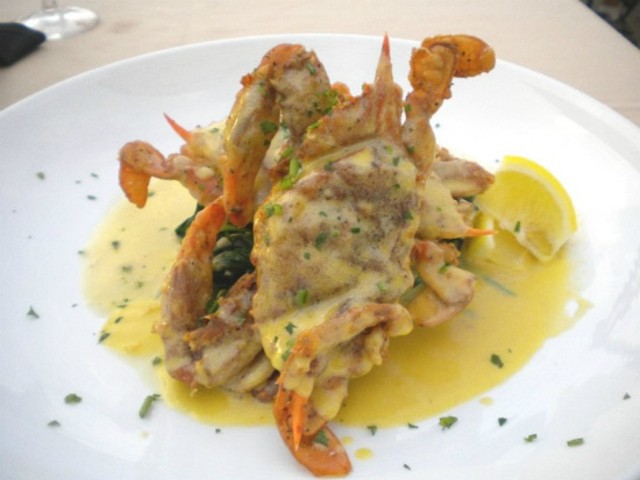The tako wasabi at Izakaya Ren is served in a bowl so small that a child could cup it in one hand. Tako is octopus, and inside the bowl is a little mound of chopped meat, slick with an unctuous, colorless sauce that gives the octopus the shine of a still-living creature. No, this isn't a meal to admire for its beauty — it isn't a meal at all, but a bar snack, best nibbled between sips of a cold Sapporo while watching the NBA playoffs on the flat-screen behind the bar. The squishy chew of the octopus is nothing like the salty crunch of bar nuts, but does the wasabi's heat make you more likely to order a second beer? It just might.
When word of Izakaya Ren's imminent arrival first circulated at the beginning of the year, local aficionados of Japanese cuisine raised their eyebrows: An izakaya is a specific kind of Japanese restaurant — or maybe not a restaurant so much as a bar or pub. Having never been to Japan, I'm not the one to paint a picture of salarymen unwinding after work with sake and skewered meat, so I asked Jay Kim, who oversees the kitchen at Izakaya Ren, to describe izakaya cuisine.
"Izakaya means like Japanese tapas," he says. "Small dishes."
Many small dishes: The menu lists dozens of items, most priced under $10 and many under $5. Granted, that latter group includes individual pieces of nigiri sushi, and as at a sushi bar, a visit here isn't about ordering one thing but a series of dishes that in the end approximate the total of lunch or dinner at a more conventional restaurant.
Izakaya Ren is located in a strip mall at the intersection of Big Bend and Dougherty Ferry roads in Valley Park, and the three-month-old restaurant looks like every other strip-mall sushi joint in St. Louis: dark and sleek, with the sushi bar in one corner of the single dining room. The sushi chefs are young, and insidiously cheery pop music plays over the sound system.
If you didn't know what an izakaya is and were drawn here simply because Izakaya Ren calls itself a sushi and sake bar, you wouldn't blink. (Though if you're hoping for an extensive sake selection, you'll be disappointed; the drink menu features only half a dozen, two of those served hot.) The menu offers all the nigiri sushi, sashimi and maki both traditional and modern (not to mention all the lunch combos and bento boxes), that we've come to expect from our sushi restaurants.
The sushi is good, if not notably distinctive. Probably best to stick with the tried and true rather than Izakaya Ren's variations. The "fresh garlic tuna" (from both the nigiri and sashimi menus) might attract your attention. The nigiri version is strange: a piece of tuna seared on one side, thus diminishing the freshness of its raw flavor, and so redolent of garlic that it seems a shame to waste a piece of tuna for it. The restaurant's namesake roll, the "Ren Special," is an exercise in crunch: shrimp, fake crab and avocado mixed with mayo, masago and tempura "crunch," rolled and then deep-fried.
Kim admits that American tastes played a role in crafting the menu here. "In the U.S., a lot of people don't like fishy stuff." He cites such basic dishes as edamame, seaweed salad and shrimp tempura as among the most popular. Still, he says, "In this place I want customers to try different stuff."
The selection of skewers (kushi yaki) is a good place to start. Each skewer holds three or four bites of meat (some with a vegetable, too), and at $2 to $3 apiece, you can afford to try several. Yakitori (chicken) is the most familiar, and the most basic, skewer. There are two variations. Yakitori shio is adorned only with salt; the dominant flavor is the grill's char. Yakitori tare tosses the chicken in a thick, lightly sweet soy-based sauce. In both cases the chicken plays the role of everymeat, more heft than flavor.
My favorite was a simple skewer of a single large shrimp wrapped in bacon. It balanced its natural flavors with those imparted by the grill, and the bacon protected the delicate shrimp from the grill's char while its smokiness rounded out the char's flavor. Thin asparagus stalks wrapped in pork belly didn't hold together very well; it was more like eating grilled pork belly with a side of asparagus — pleasantly fatty but ultimately unremarkable.
Of course, when a restaurant has a menu as lengthy as Izakaya Ren's, the challenge of trying something different can be daunting. The tako wasabi, for example, is one of sixteen dishes in the category called "Cold Items." There are entire rice bowls (including fried rice with spam) and noodle bowls and something (which I regretfully didn't even notice until now, as I look over a takeout menu) called "corn cheese." Just sorting through the fried and grilled dishes (age mono and yaki mono, respectively) is overwhelming. Though I can advise against ordering the agedashi tofu. The squares of fried tofu drown and dissipate in a soup of sweet sauce.
My best advice is not only to take Kim at his word that he wants you to try something different, but to engage him and the rest of the staff in conversation and see what transpires. On my final visit, sitting at the bar, I ordered the tako wasabi and the fried saba (mackerel). While I ate the octopus, one of the sushi chefs asked if I'd ordered the saba. Visibly excited, he said, "Because we're not busy, I'll make you the special version."
What was this? An entire mackerel, minus the head, sliced in half lengthwise, dredged in flour and then deep-fried. The top half of the fish was the meaty half, with the slightly oily texture and strongly fishy flavor that makes mackerel an acquired taste. (I love it.) The bottom half had a little bit of meat on it but was mostly bone. Which, the chef informed me, I should eat. Dipped in a nicely astringent sake-based sauce, it was terrific: crisp, crunchy, not as fishy as the meaty half, but still definitely mackerel.
How closely does Izakaya Ren hew to a true izakaya? I have no basis for comparison. But before I went, I had no basis for comparison of deep-fried mackerel bones. Now I do.






